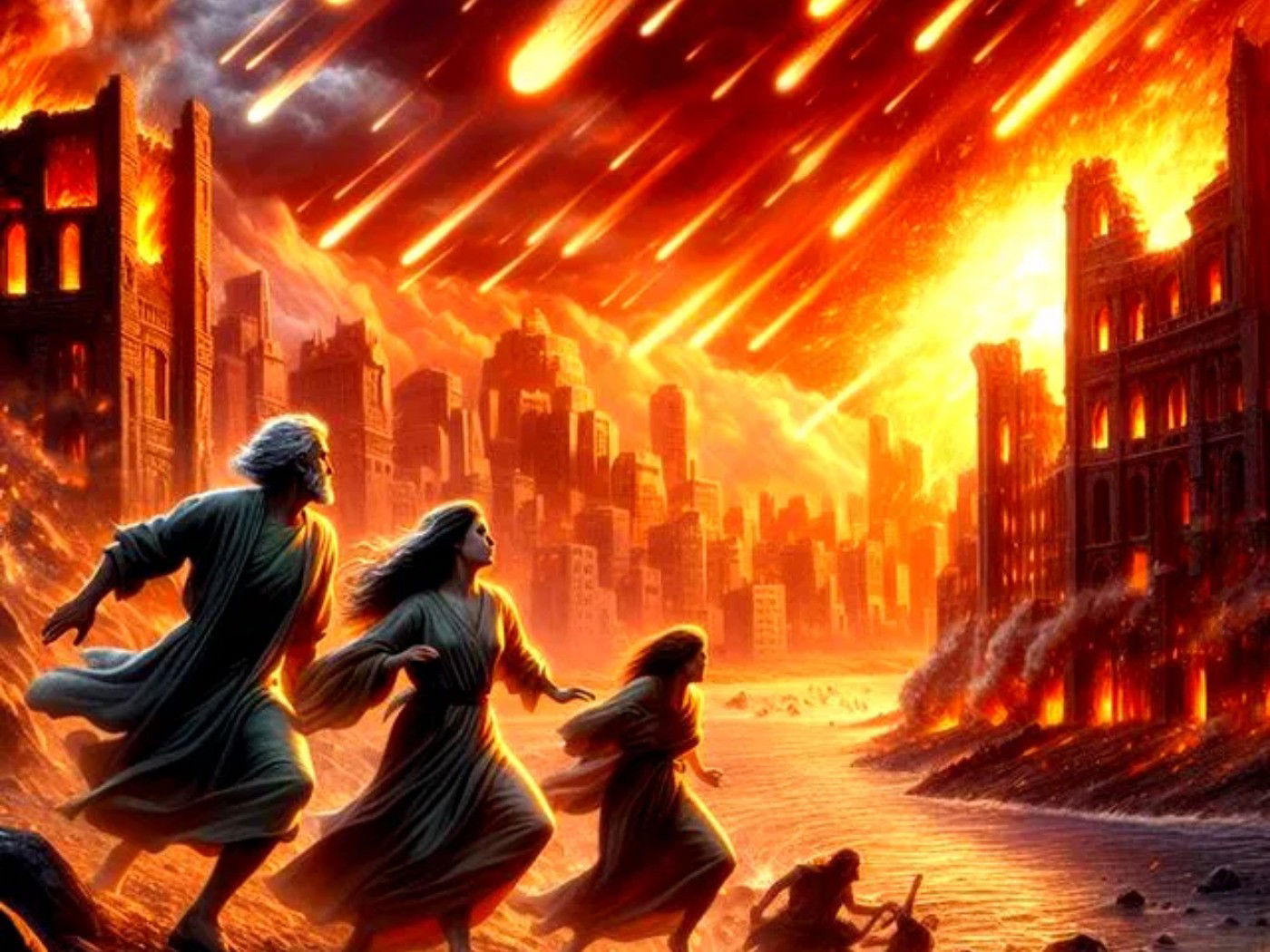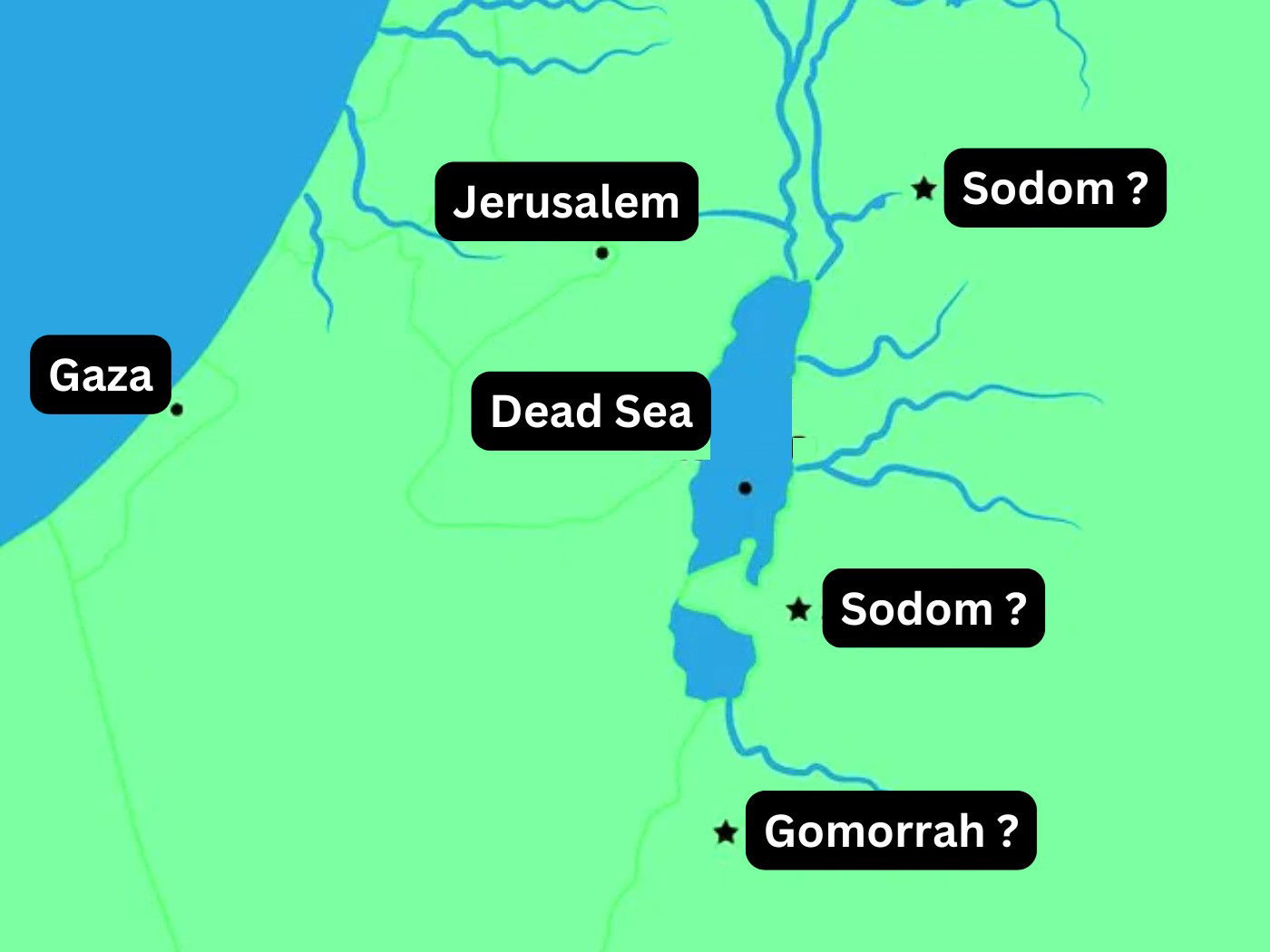Sodom and Gomorrah were ancient cities destroyed by God because of their many sins. Their story is mentioned in the Bible, in the book of Genesis. They were located in the Valley of Siddim, near the plains of the Jordan River, where today is known as the coast of the Dead Sea, in Israel.
These cities were consumed by fire and sulfur that fell from the sky due to their great depravity and sexual immorality. Abraham interceded for God to spare the cities if at least 10 honest and righteous people could be found there. However, the only righteous man found was Lot, Abraham's nephew, who was rescued along with his family. From that terrible destruction, only Lot and his two daughters survived, as his wife stayed behind during the escape.
 In the biblical narrative, Sodom, Gomorrah, Admah, Zeboiim, and Zoar were part of a very productive region known as the Fertile Crescent. These five cities were in the valley of the Jordan River and along the coast of the Dead Sea. This land was of fascinating beauty, compared to the "garden of the Lord" (Genesis 13:10).
In the biblical narrative, Sodom, Gomorrah, Admah, Zeboiim, and Zoar were part of a very productive region known as the Fertile Crescent. These five cities were in the valley of the Jordan River and along the coast of the Dead Sea. This land was of fascinating beauty, compared to the "garden of the Lord" (Genesis 13:10).
The region also experienced growing economic development. There was an abundance of resources, such as the tar pits mentioned in the Bible (Genesis 14:10). This mineral was used in construction, indicating that the houses in the area were well-structured, as intended in the construction of the Tower of Babel (Genesis 11).
In addition to the abundance of natural resources, Sodom and Gomorrah economically benefited from their location on an important trade route that extended through those kingdoms. The inhabitants had the means to enjoy a comfortable and prosperous life in those times.
Before the destruction, the region was stunning. So impressive that it attracted Lot, Abraham's nephew, who chose to live there when he parted ways with his uncle. The land was vast, flat, and fertile, providing abundant food and pasture for the inhabitants and their herds.
 However, the Bible repeatedly emphasizes that the people who inhabited that region "were exceedingly wicked and sinned greatly against the Lord" (Genesis 13:13). They committed a series of sins and injustices, including sexual immorality, unnatural relations, rape, violence, injustice, adultery, and collective abuse. Despite their wickedness, they showed neither repentance nor mercy.
However, the Bible repeatedly emphasizes that the people who inhabited that region "were exceedingly wicked and sinned greatly against the Lord" (Genesis 13:13). They committed a series of sins and injustices, including sexual immorality, unnatural relations, rape, violence, injustice, adultery, and collective abuse. Despite their wickedness, they showed neither repentance nor mercy.
They proudly displayed their sins without feeling shame (Isaiah 3:9). Therefore, in various biblical passages, these cities "were set forth as an example of the punishment of eternal fire" (Jude 1:7) that will come upon the wicked.
Thus, God punished the inhabitants of the five cities, destroying them with a rain of fire and sulfur. However, God had a covenant with Abraham, and his nephew Lot lived in Sodom with his family. Abraham interceded for them, and God sent His angels to save them before the terrible destruction.
How the Destruction of Sodom and Gomorrah Happened
God heard the outcry against the wickedness of those people and decided to intervene. He informed Abraham, the Hebrew patriarch, about His intention to destroy those cities. Abraham interceded for the righteous people, including Lot and his family.
God agreed to spare the cities if He could find at least ten righteous people in them. However, when two angels were sent to verify, they did not find even this minimum number. Only Lot and his family would be saved from the destruction.
The angels, disguised as travelers, were welcomed by Lot, who invited them to stay in his house. But during the night, they were surprised. All the men of the city, young and old, surrounded Lot's house, demanding that the foreigners be handed over so they could abuse them.
In total desperation, Lot even offered his daughters instead of the angels, but the men violently resisted. They threatened to harm Lot as well, attempting to break into the house. But the angels protected Lot, pulling him inside and blinding the men. They advised Lot to leave immediately to escape the imminent destruction.
The visitors sent by God led the family to safety, but Lot's wife looked back, disobeying the divine command, and was turned into a pillar of salt.
Thus, God sent fire and sulfur from the sky, completely destroying those cities, their inhabitants, and all vegetation, except for Zoar, a distant small town where Lot and his daughters fled for shelter. The other four cities were punished and exterminated.
The surrounding region became so dry and barren that even today it is known for its salinity and unproductiveness, near the Dead Sea.

Why God Destroyed Sodom and Gomorrah
Sodom and Gomorrah faced God's judgment due to their great wickedness and sin. God had grown weary of their evil and many crimes, so He decided to punish them by destroying the cities in such a way that no trace of their decadent greatness would remain.
Scripture describes the inhabitants of these cities as completely depraved, corrupt, and guilty of various sins, including violence, homosexuality, hostility toward foreigners, disdain for the needy, and lack of hospitality toward visitors.
Because of this total depravity, Sodom became associated with homosexuality, giving rise to the term "sodomy," from the Latin peccatum Sodomiticum—the sin of Sodom. Additionally, other sexual sins such as abuse, rape, and bestiality were committed without punishment.
However, the Bible does not limit itself to mentioning only these sins. In the book of the prophet Ezekiel, it is mentioned that Sodom and the other cities "were proud, had an abundance of food, and enjoyed prosperous ease, but did not help the poor and needy. They were arrogant and committed abominations before God" (Ezekiel 16:49-50).
This confirms that the cities had stability and material wealth, but they did not care for the less fortunate. They were proud and immoral in their conduct. Moreover, they did not consider that their greed and licentiousness could be condemned and punished by the Creator. They despised God.
What is the Current Location of Sodom and Gomorrah?
Despite controversies, it is likely that Sodom and Gomorrah were located south of the Dead Sea. However, the destruction was so severe that the cities were completely wiped out.
For decades, scholars and archaeologists have been searching for physical evidence of the exact location of the cities, but nothing conclusive has been found yet. Recent excavations at the site of Tall el-Hammam, north of the Dead Sea, near the Jordan River, raise the possibility that Sodom may have been located there.

However, other scholars believe that the cities of sin were located on the southern coast of the Dead Sea. This seems to be the likely location, considering the study of all biblical passages.
Today, Mount Sodom, located east of the Dead Sea, is a tourist attraction, even featuring the supposed statue of Lot's wife. However, there is no archaeological evidence linking it to the ancient cities.
Sodom, Gomorrah, and the End Times
The Bible mentions that in the end times, humanity will experience a great moral decline and an increase in the inclination to sin. It cites the example of Sodom and Gomorrah and emphasizes the punishment that will come upon those who do not repent of their wickedness before God.
It was the same in the days of Lot. People were eating and drinking, buying and selling, planting and building. But the day Lot left Sodom, fire and sulfur rained down from heaven and destroyed them all.
- Luke 17:28-29
The arrogance and grandeur of these cities were manifested in the absence of honor, morality, justice, and generosity. The people were wealthy and prosperous but extremely selfish, proud of their status, and despised the socially disadvantaged, such as the poor and foreigners.
God is the Just Judge and will punish sin. But God is also the God of love and gives us opportunities to examine ourselves and repent of our wickedness. If we sincerely ask for His forgiveness, He is faithful and just to forgive us and transform us.
The day will come when everything we have and see today will end. Although evil grows around us, we must keep our hearts alert to the voice of God. Turn to Him! Through Jesus, we can have hope for an eternal future with God.
